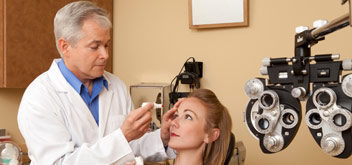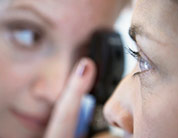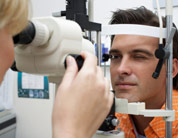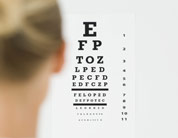Eye And Vision Terms
Common and not-so-common eye and vision terms.

We want to make sure you're completely comfortable when you visit the eye doctor for your eye exam*. This comprehensive glossary will help explain many of the medical and procedural words and terms you may hear before, during or after your exam. As always, if you have any questions regarding your exam, or would like to have something explained a little more clearly, don't hesitate to ask your doctor*.
Read More

Eye conditions and diseases
- Amblyopia Commonly called "lazy eye." It is the loss or lack of central vision in one eye or the inability of the eye to focus.
- Astigmatism An additional curvature on the surface of the cornea, or lens of the eye, that makes it difficult to focus. Can result in headaches and, in more severe cases, blurred vision.
- Cataracts Opacity or cloudiness that usually develops gradually as the lens in the eye loses transparency and the lens material yellows. Cataracts are the leading cause of visual disability in people older than 65.
- Conjunctivitis An inflammation of the conjuctiva, the thin, transparent layer that lines the inner eyelid and covers the white part of the eye.
- Diabetic Retinopathy Blood vessels that nourish your eye's retina might begin to leak, swell or develop brush-like branches. Progression of the disease can produce cloudiness of vision, blind spots or floaters.
- Diplopia Also known as double vision.
- Dry Eye Occurs when tear glands produce too few tears, causing itching, burning or even reduced vision.
- Farsightedness A vision condition in which distant objects are usually seen clearly, but close ones do not come into proper focus.
- Floaters Tiny spots or specks that float across the field of vision. Generally harmless, they can be a warning of certain eye problems, especially if there is a sudden change.
- Glaucoma A condition in which the pressure in the eye increases, causing eye damage and potential blindness. A leading cause of blindness in the United States, glaucoma can be prevented if the disease is detected and treated in time.
- Macular Degeneration The progressive deterioration of the part of the retina responsible for central vision and a leading cause of blindness in America.
- Nearsightedness A vision condition in which near objects are seen clearly, but distant objects do not come into proper focus.
- Ocular Hypertension An increase in the pressure in your eyes with no detectable changes in vision or damage to the eyes. The term is used to distinguish people with elevated pressure from those with glaucoma. It is also more common in people who are very nearsighted or who have diabetes.
- Presbyopia Gradual decline in the ability to focus on close objects or to see small print. Regardless of your prior vision correction needs, presbyopia is considered a normal and almost inevitable part of the aging process.
- Retinal Detachment The separation of the light-sensitive membrane in the back of the eye (the retina) from its supporting layers.
- Sclera The tough, white outer layer of the eyeball; with the cornea, it protects the entire eyeball.
- Strabismus Also known as "cross eyes." One or both eyes turn in, out, up or down, independent of the other eye.
Read More

Eye doctor's equipment
- Automated Visual Fields Determine peripheral and central vision disorders.
- Autorefractor Determines nearsightedness, farsightedness and astigmatism.
- Biomicroscope/Slit Lamp Examines the eye in layer-by-layer detail.
- Intraocular Pressure Pressure of the fluid inside the eye; normal IOP varies among individuals.
- Keratometer An instrument used to check the front curvature of the cornea's surface. This test is important for anyone interested in contact lenses.
- Lensometer Measures the power of your current prescription lenses.
- Ophthalmoscope A noninvasive, handheld instrument that allows the doctor to examine the internal portion of the eye for a wide range of problems.
- Phoropter A mask-like instrument positioned so that each eye sees through a separate lens.
- Tonometer Tests eyes for increased intraocular pressure (glaucoma).
Read More

Eye exams a doctor* may perform
- Amblyopia Commonly called "lazy eye." It is the loss or lack of central vision in one eye or the inability of the eye to focus.
- Astigmatism An additional curvature on the surface of the cornea, or lens of the eye, that makes it difficult to focus. Can result in headaches and, in more severe cases, blurred vision.
- Cataracts Opacity or cloudiness that usually develops gradually as the lens in the eye loses transparency and the lens material yellows. Cataracts are the leading cause of visual disability in people older than 65.
- Conjunctivitis An inflammation of the conjuctiva, the thin, transparent layer that lines the inner eyelid and covers the white part of the eye.
- Diabetic Retinopathy Blood vessels that nourish your eye's retina might begin to leak, swell or develop brush-like branches. Progression of the disease can produce cloudiness of vision, blind spots or floaters.
- Diplopia Also known as double vision.
- Dry Eye Occurs when tear glands produce too few tears, causing itching, burning or even reduced vision.
- Farsightedness A vision condition in which distant objects are usually seen clearly, but close ones do not come into proper focus.
- Floaters Tiny spots or specks that float across the field of vision. Generally harmless, they can be a warning of certain eye problems, especially if there is a sudden change.
- Glaucoma A condition in which the pressure in the eye increases, causing eye damage and potential blindness. A leading cause of blindness in the United States, glaucoma can be prevented if the disease is detected and treated in time.
- Macular Degeneration The progressive deterioration of the part of the retina responsible for central vision and a leading cause of blindness in America.
- Nearsightedness A vision condition in which near objects are seen clearly, but distant objects do not come into proper focus.
- Ocular Hypertension An increase in the pressure in your eyes with no detectable changes in vision or damage to the eyes. The term is used to distinguish people with elevated pressure from those with glaucoma. It is also more common in people who are very nearsighted or who have diabetes.
- Presbyopia Gradual decline in the ability to focus on close objects or to see small print. Regardless of your prior vision correction needs, presbyopia is considered a normal and almost inevitable part of the aging process.
- Retinal Detachment The separation of the light-sensitive membrane in the back of the eye (the retina) from its supporting layers.
- Sclera The tough, white outer layer of the eyeball; with the cornea, it protects the entire eyeball.
- Strabismus Also known as "cross eyes." One or both eyes turn in, out, up or down, independent of the other eye.
Read More
Eye care professionals
- Ophthalmologist A physician (doctor of medicine or doctor of osteopathy) who specializes in the comprehensive care of the eyes and visual system and the prevention of eye disease and injury. The ophthalmologist is a physician who is qualified by lengthy medical education, training and experience to diagnose, treat and manage all eye and visual system problems, and is licensed by a state regulatory board to practice medicine and surgery.
- Optician Professionals in the field of designing, finishing, fitting and dispensing of eyeglasses and contact lenses, based on an eye doctor's prescription. The optician also might dispense colored and specialty lenses for particular needs, as well as low-vision aids and artificial eyes.
- Optometric Assistant Primarily involved in front-office procedures, optical dispensing and contact lens patient education. A registered optometric assistant is designated by Opt. A., R.
- Optometric Technician Through academic and clinical experience, these technicians are prepared for diverse job duties. Technicians work directly with optometrists in the areas of patient examination and treatment, including contact lenses, low vision, vision therapy, optical dispensing and office management. A registered optometric technician is designated by Opt. T., R.
- Optometrist Independent healthcare providers who examine, diagnose, treat and manage diseases and disorders of the visual system, the eye and associated structures. They are also trained to diagnose related systemic conditions. Optometrists are state-licensed healthcare professionals. They prescribe glasses, contact lenses, low-vision rehabilitation, vision therapy and medications; They hold a doctor of optometry (O.D.) degree.
- Paraoptometric Working under the direct supervision of a licensed doctor of optometry, they collect patient data, administer routine yet technical tests of the patient's visual capabilities and assist in office management. The paraoptometric also might assist the optometrist in providing primary patient care examination and treatment.



